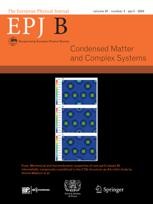Antiferromagnet lattice arrangements influence phase transitions
Calculations involving ‘imaginary’ magnetic fields show how the transitioning behaviours of antiferromagnets are subtly shaped by their lattice arrangements.
New York | Heidelberg, 25 September 2020
 Antiferromagnets contain orderly lattices of atoms and molecules, whose magnetic moments are always pointed in exactly opposite directions to those of their neighbours. These materials are driven to transition to other, more disorderly quantum states of matter, or ‘phases,’ by the quantum fluctuations of their atoms and molecules – but so far, the precise nature of this process hasn’t been fully explored. Through new research published in EPJ B, Yoshihiro Nishiyama at Okayama University in Japan has found that the nature of the boundary at which this transition occurs depends on the geometry of an antiferromagnet’s lattice arrangement.
Antiferromagnets contain orderly lattices of atoms and molecules, whose magnetic moments are always pointed in exactly opposite directions to those of their neighbours. These materials are driven to transition to other, more disorderly quantum states of matter, or ‘phases,’ by the quantum fluctuations of their atoms and molecules – but so far, the precise nature of this process hasn’t been fully explored. Through new research published in EPJ B, Yoshihiro Nishiyama at Okayama University in Japan has found that the nature of the boundary at which this transition occurs depends on the geometry of an antiferromagnet’s lattice arrangement.
Nishiyama’s discovery could enable physicists to apply antiferromagnets in a wider variety of contexts within material and quantum physics. His calculations concerned the ‘fidelity’ of the materials, which refers in this case to the degree of overlap between the ground states of their interacting lattice components. Furthermore, the fidelity ‘susceptibility’ describes the degree to which this overlap is influenced by an applied magnetic field. Since susceptibility is driven by quantum fluctuations, it can be expressed within the language of statistical mechanics – describing how macroscopic observations can arise from the combined influences of many microscopic vibrations. This makes it a useful probe of how antiferromagnet phase transitions are driven by quantum fluctuations.
Using advanced mathematical techniques, Nishiyama calculated how the susceptibility is affected by ‘imaginary’ magnetic fields – which do not influence the physical world, but are crucial for describing the statistical mechanics of phase transitions. By applying this technique to an antiferromagnet arranged in a honeycomb lattice, he revealed that the transition between orderly, anti-aligned magnetic moments, and a state of disorder, occurs across a boundary with a different shape to that associated with the same transition in a square lattice. By clarifying how the geometric arrangement of lattice components has a subtle influence on this point of transition, Nishiyama’s work could advance physicists’ understanding of the statistical mechanics of antiferromagnets.
References: Y Nishiyama (2020), Fidelity-susceptibility analysis of the honeycomb-lattice Ising antiferromagnet under the imaginary magnetic field, European Physical Journal B 93:174, DOI: 10.1140/epjb/e2020-10264-5
Further Information
For more information visit: www.epj.org
Services for Journalists
The full-text article is available here.
Contact
Sabine Lehr | Springer | Physics Editorial Department
tel +49-6221-487-8336 | sabine.lehr@springer.com
